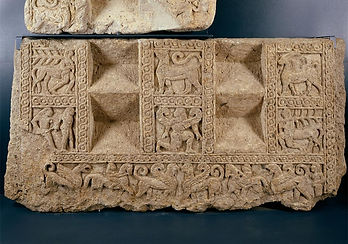Impacts of Interactions

Bronze engraved mirror

Door of a chamber tomb, depicting Greek animals from Tarquinia
The Etruscan civilization occupied the territory of Northern Italy, stretching along the western coast overlooking what is currently known as the Tyrrhenian Sea. Etruria’s vast expanse was rich in precious metals, and the southernmost portion was extremely fertile. These factors, coupled with access to the aforementioned Sea, provided the fledgling power with multiple advantages in the arena of commerce. As early as the second millennium, BC, Volaterrae villages in Etruria were exploiting their access to raw metals for economic gain. This process of villages (and later city-states) mining, manufacturing, and trading precious metals survived throughout Etruria’s existence and ultimately outlived the Etruscan civilization.
Through Etruria’s monetary influence was undeniably far-reaching and powerful, the Etruscan navies and armies would prove to be a formidable force upon other entities and cultures. The Etruscan navy was at its strongest at the beginning of the seventh century BC, where it seems to have functioned largely in aid of merchant ships. The “Tyrrhenian” Sea receives its name from the Greek word for the Etruscans, who were extremely active in the area.
The Etruscan civilization’s impact on the cultures of Classical Greece and Rome, respectively, cannot be underestimated. Having developed into a coalition of city-states centuries before Greece or Rome, Etruria served as a prototype of the city-state model for these illustrious civilizations, to the point where it has been said that the villages of Rome merged “in imitation” of the Etruscan communities.
Classical Greece was one of the greatest influences of Etruscan art, which emulated the Greek architecture and pottery. Many Greeks migrated to Etruria and influenced its culture, particularly in the way of its Gods, and Etruria developed strong and long-lasting cultural bonds with their Balkan comrades, which survived when political connections did not.
Classical Greek documents often refer to Etruscans as “pirates”, and it is speculated that much of this animosity stems from jealousy of Etruscan trading success, as the Greeks were competitors against the Etruscans in the Mediterranean market. This tense state of affairs culminated in armed altercations between Greece and Etruria throughout the early and mid-sixth century. The conflicts never amounted to full-scale wars, and neither nation emerged any richer. Ironically, however, the Etruscans’ full body armor which emerged at the time was initially inspired by Greek armor. This would prove to be an advantage for the Etruscans, who were much better armed than their Greek enemies due to the availability of the raw metals in Etruria. The first full-body set of bronze armor was found in Rome, having arrived there in the seventh century from Etruria.
Rome, located just south of Etruria, shared more than locality with the Etruscan Civilization. As has been previously stated, the crystallization of the original Roman city-state was modelled after that of its Etruscan compeers. The coagulation of the Etruscan city-states into a fully-fledged civilization and those states’ expansion into the surrounding villages and countryside, too, mirrors the rise what would eventually be known as the Roman Empire. Furthermore, the existence of Etruscan armor in Rome dated before Etruscan-Roman hostilities implies another, likely economic, connection.
Though not quite at the level of their progenies, Etruscan city-states were apt and innovative in the arena of plumbing. Their intricate and effective drainage and irrigation systems strongly influenced the design and construction process of the famed Roman aqueducts. The segmented arch, a staple of Roman architecture and a key aspect of the Roman sewer system, was likely invented by Etruscans.
Beyond technological advancements, the twelve month calendar system, their respective “ides”, and the name “Aprilis” (which would eventually evolve into the contemporary term “April”) were all adapted by the Romans from their Etruscan forerunners. The names that Romans used, which consisted of a first and clan name, were also leftover from Etruscan titles. The “triad of principle Etruscan gods [1]” corresponds with the Roman triad of Jupiter, Juno, and Minerva.
The influence that Etruria had on Rome was truly staggering, from the mundane aspects of everyday life to the aspects of Roman culture which would influence the course of Western Civilization forever. Much like Saturn and his children, however, The Etruscan civilization was to be destroyed by the creation it begot.
Rome’s aggressive desire to expand caused the southern city-states of Etruria, particularly Volsinii and Clusium, to come into conflict with Roman military forces more and more frequently throughout the fourth century. As the altercations increased in scale and frequency, Rome began to take control of certain portions of Volsinii, eventually sacking the entirety of the city-state by the middle of the third century. By this point, Etruria had formed an alliance with the Umbrians, Samnites, and the Gauls, but even the combined might of these civilizations could not stave off the Romans, who had effectively taken Etruria by 225, BC, making allies of the formerly independent city-states.
[1] Robert Hughes, Rome: A Cultural, Visual, and Personal History (London: Hodder Headline, 2011), 22.